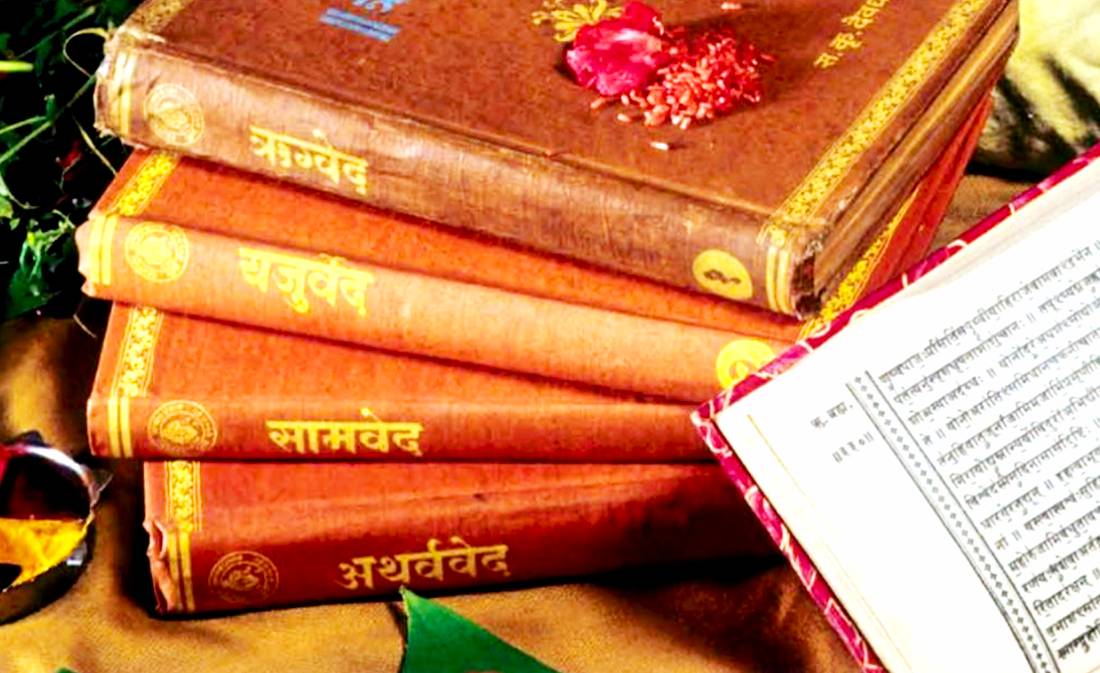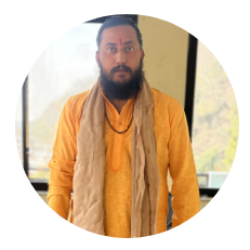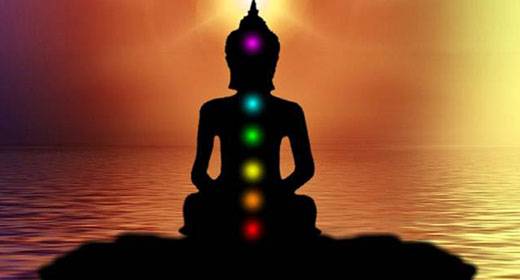HISTORY OF VEDA
VEDABHOOMI - the land of knowledge, one of the names of India. Long before the Islamic invasions and European colonization, India was one of the very few civilizations which has a very advanced education system of that time. From Western Europe to China people travelled to India to understand its rich knowledge system. Travellers like Megasthenes, Al-Biruni and Hiuen Tsang have mentioned how advanced was the Indian education system at that time in their respective books. The knowledge of ancient India is one of the most comprehensive and complex education systems in the world. The heritage of the Vedic Education & Value system has been largely preserved by the inscriptions on the temples, manuscripts and verbally transmitted from a teacher to the students (Guru Shisya Parampara). The era between 1500BCE and 500 BCE is known as the Vedic Period due to the compilation of Veda. According to the puranic tradition, Ved Vyasa compiled all the four Vedas and later taught Rigveda Samhita to Paila. An alternate version states that Shakala complied the Rigveda from the teaching of Vedic rishis.
VEDAS - THE POWERFUL TEXT OF HINDUISM
Vedic Literature is an ancient composition of Vedic Culture. The Vedic Literature comprises 4 literary productions -
- The Samhitas or Vedas
- The Brahmana Granth
- The Aranyakas
- The Upanishads
The Brahmana Granth: is the prose part of the Vedas by which one can understand and study the Veda. Every Veda has its separate Brahmana Granth.
The Aranyakas: are the text written in forests. That's why they are also known as "Van Pustak". These are basically written for students and sages, who used to live in forests. The Aranyakas describes Mystery and Darshnik Siddhanta (Philosophical Doctrine).
The Upanishads : are the Vedic Sanskrit texts concluding the relation between humans, the gods and the universe.
THERE ARE 4 VEDAS:
Rig Veda
Samaveda
Yajurveda
Atharvaveda
The first 3 Vedas are jointly called "Vedatrayi", i.e. trio of Vedas. The Atharvaveda is not included in this trio as it was later discovered. All four Vedas together are known as, "Samhita". The creation of the Rigveda was done in the "Rig Vedic Period" while the other three were created in the "Later Vedic Period".
RIG VEDA
The Sanskrit word "Rig" means "Hymns" or "Lyrics". It is the oldest text in the world and the first testament of mankind. It is believed that the "Rig Veda" was created in the region, "Sapt Sindhu" or "Sapt Sendhav". It is one of the most important texts of the Hindu tradition. It describes the hymns in the praise of the Gods, which are recited in various rituals. The hymns in Rigveda describe, and praise the properties of various natural elements around us, giving them personified forms of Agni, Indra, Mitra, Varuna, Soma, and so on. The philological and linguistic evidence indicates that the Rigveda is one of the ancient existing texts in any Indo-European language and was composed as early as around 1500BCE.
The hymns of Rigveda were traditionally recited by the Hotri (or Hota) priests. The Rig Veda contains 1028 hymns (original - 1084 hymns) divided into 3 chapters (or shakhas) as follows.
Shakala - It contains 1017 hymns
Balkhilya - It contains 11 hymns
Bhaskala - It contains 56 hymns but all these are not available
The Rig Veda contains 10,600 verses divided into 10 Mandalas. The 6 mandalas (from 2nd to the 7th) are called "Gotra" or "Vamsha Mandalas". The 8th, 9th and 10th mandalas are said to be added later.
The 10th Mandala contains the famous "Purusha Sukta" which explains the 4 varnas - Brahmana, Kshatriya, Vaishya and Shudra.
The 9th Mandala mentions the Vedic God, "Soma".
The 3rd Mandala contains the most spiritual "Gayatri Mantra". The same mandala also mentions the God "Sun" with the name "Savitri".
Upaveda of Rigveda
Ayurveda (The science of medicines)
Brahmana Granth of Rigveda
Aitareya Brahmana and Kausitaki Brahmana
Aitareya Brahmana - It was ascribed by Mahidas Aitareya. It defines the coronation of the King.
Kausitaki Brahmana - It was ascribed by Kausitaki Rishi. It describes various types of Yagyas (Fire Rituals).
Aranyaka of Rigveda
Aitareya and Kausitaki.
Upanishad of Rigveda
Aitareya and Kausitaki.
YAJUR VEDA
The second classification is called the Yajurveda, where the word yajus literally means ‘a practice, worship, or a ritual. It dates back to 1100-800 BCE; corresponding to Samaveda. The Yajurveda is also considered significant for its presentation of philosophical doctrines. It explains different procedures for the worship of nature and the cosmos. That is why it is also known as "Karma Kandiya Veda". It is the only Veda that is divided into 2 parts, namely
Krishna Yajurveda - It is written in prose and poetry. The verses of Krishna Yajurveda are unclear, unarranged, and disparate, dissimilar
Shukla Yajurveda - It is written in prose. The verses in Shukla Yajurveda are well-arranged and impart a particular meaning.
It has 1875 verses. The hymns of Yajur Veda were recited by Adhvaryus.
Upaveda of Yajurveda
Dhanurveda (The science of Archery)
Brahmana Granth of Yajurveda
Shatapatha Brahmana and Taittiriya Brahmana
Shatapatha Brahmana - It is the oldest and the longest text of the Vedas, written by Yagya Valakya Rishi.
Taittiriya Brahmana - It is related to Krishna Yajur Veda.
Aranyaka of Yajurveda
Brihadaranyaka, Taittriya Aranyaka, and Shatapatha.
Upanishad of Yajurveda
Brihadaranyaka Upanishad, the Isha Upanishad, the Taittiriya Upanishad, the Katha Upanishad, the Shvetashvatara Upanishad and the Maitri Upanishad.
The Taittiriya Upanishad describes the behaviour a student should have towards Guru (Teacher).
The Katha Upanishad/Kathopanishad mentions Heaven and Hell, Dialogues between Yam and Nachiketa.
SAMA VEDA
Sama means ‘song’, the Samaveda means melody of knowledge or song or knowledge. It dates back to 1200-800 BCE. It gives a music-driven canonical format to other Vedas for ease of recitation. It is a work of liturgical songs, chants and texts meant to be sung.
It contains 1869 chants/mantras (verses), out of which 320 were repeated. All the verses except verse 75 & verse 99 had been taken from the Rigveda. The hymns of the Samaveda were recited by Udgātṛ or Udgātā. The seven swaras of Indian classical music are taken from the Samaveda.
Samaveda is also considered the root of the Indian classical music and dance tradition. The text of this Veda has useful information about agriculture, economic and social life during the Vedic period.
The mantra of Surya Stuti is mentioned in Samaveda. The first mention of Veena (the musical instrument of Goddess Saraswati) was found in this Veda.
Upaveda of Samaveda
Gandharva Veda (The science of Music)
It is written by Bharat Muni
Brahmana Granth of Samaveda
Panchavimsha / Tandya Brahmana and Jaiminiya Brahmana
- Panchavimsha / Tandya Brahmana - It contains 25 Adhyays (Chapters) and so also known as MahaBrahmana.
- Jaiminiya Brahmana - It defines prayers and Vedic sacrifices.
Aranyaka of Samaveda
Jaiminiya Aranyaka and Chhandogya Aranyaka.
Upanishad of Samaveda
Chandogya Upanishad and Kena Upanishad
ATHARVA VEDA
The word 'Atharva" was formed by combining the words, "Athar" and "Vani", which means "to ward off evil sites". This scripture is also known as “the Veda of Magic Formulas”. It is more often viewed not in connection with the three other Vedas but as a discrete scripture. The Atharvaveda is a mixture of hymns (for marriage and cremation), chants, magical rites, spells (to dispel demons and disease), and prayers. It consists of 730 hymns (suktas), 6000 mantras, and 20 mandalas. The hymns of Atharva Veda were recited by "Brahma".
The Atharva Veda is indeed a collection of all sorts of speculations that quite often leave us bewildered. It is the only Veda that is related to both worldly happiness and spiritual knowledge.
It is also known as Brahma Veda and Shrestha Veda.
Silver and Sugarcane were mentioned for the first time in this Veda. The word "Gotra" is also mentioned for the first time in this Veda.
Upaveda of Atharva Veda
It is written by Rishi Vishwamitra.
Brahmana Granth of Atharva Veda
Gopatha Brahmana
It is written by Gopatha Rishi.
Aranyaka of Atharva Veda
There is no Aranyaka of Atharva Veda.
Upanishad of Atharva Veda
Mundaka Upanishad, Mandukya Upanishad and Prashna Upanishad.
The National Motto of India, "Satyameva Jayate" (Truth Alone Triumphs) has been taken from the Mundaka Upanishad or Mundakopanishad.
Mandukya Upanishad or Mandukyopanishad is the smallest Upanishad.
VEDIC MANTRAS
Calms the Mind
Balances the Chakras
Increases Memory
Results in Healthy Heart
Provides Inner Peace
Calms the Mind
the mind. Further, it stimulates the hormones that calm and cool the mind. The vibrations produced by the chanting of a mantra helps an individual to increase their concentration and focus.
Balances the Chakras
While chanting the mantras, the body’s chakras get stimulated. Different chakras help in different functions of the body. For a healthy and disease-free life, it is necessary to balance the chakras. Regular chanting helps in aligning and balancing the chakras.
Increases Memory
As per many scientific studies, the chanting of mantras improves the memory and learning power of a person. When you chant a mantra, it produces vibrations that activate the chakras present in your head and face. This chakra is responsible for memory and concentration power.
Results in Healthy Heart
Chanting a Vedic Mantra regularly calms you down, which results in slowing down the breathing process. This further keeps your heart healthy.
Provides Inner Peace
The regular practice of Vedic mantra chanting is beneficial in providing inner peace. Chanting will soothe your soul, which results in calming down your spirit.
IMPORTANCE OF VEDAS
Vedas are the best preparation for life. If someone is able to understand the Vedas can learn lifestyle. Learning the Vedas make us familiar with our past, our roots, our ancestors. We get to know the spiritual significance of the world. We understand the importance of the life we have.
We will be able to conquer the problems if we continue reading the Vedas. The spiritual life is away from negativity. Negativity thoughts leads to physical and mental disorders. Gaining the information and knowledge of the Vedas, we can overcome those negativities, fears, worries, and so on.
The basic concept of Vedic Education is to train people in a way that helps them live their life peacefully. It further develops the character and personality of a person.





